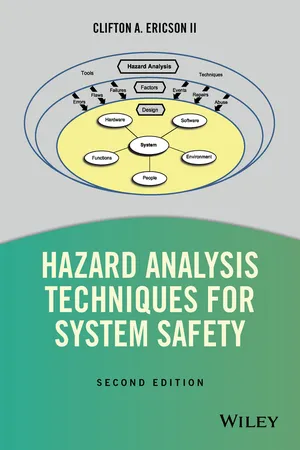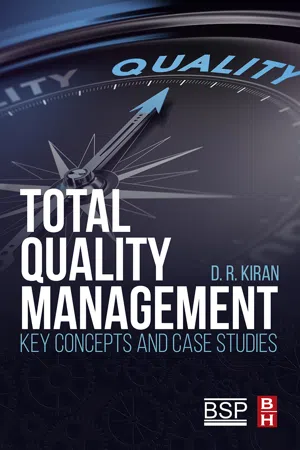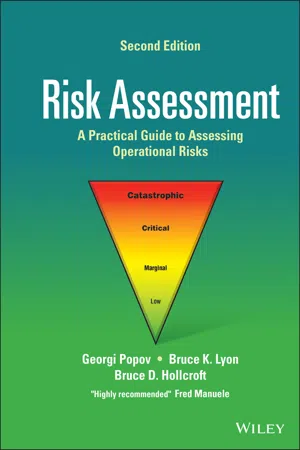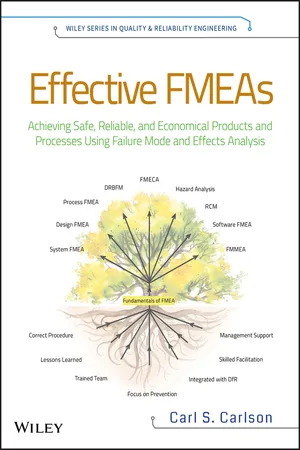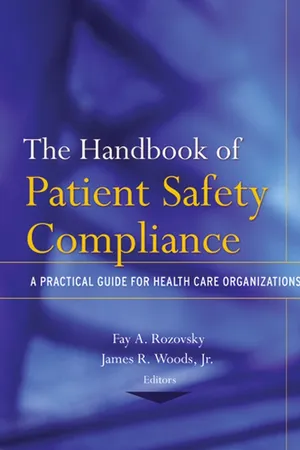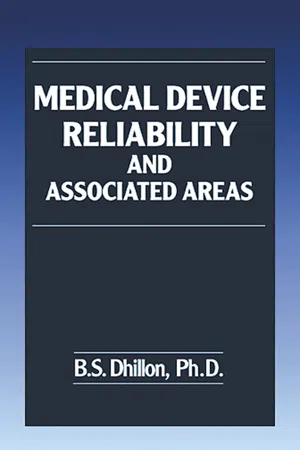Technology & Engineering
FMEA Risk Assessment
FMEA (Failure Mode and Effects Analysis) Risk Assessment is a systematic method for identifying and evaluating potential failure modes within a system, product, or process. It involves analyzing the potential effects of these failures and prioritizing them based on their severity, occurrence, and detectability. This helps in proactively addressing and mitigating risks to improve the reliability and safety of the technology or engineering system.
Written by Perlego with AI-assistance
Related key terms
1 of 5
11 Key excerpts on "FMEA Risk Assessment"
- eBook - PDF
Validating Pharmaceutical Systems
Good Computer Practice in Life Science Manufacturing
- John Andrews(Author)
- 2005(Publication Date)
- CRC Press(Publisher)
How does it do this? It all comes down to risk assessment and management of component failure. This requires tremendous discipline and you must stand by your decisions, even if it means letting down a whole planeload of angry passengers who want to board a plane home when returning from their holiday in the Canaries at 2:00 A . M . because the public address system does not work. In this chapter we review a selection of different formal techniques, look at their strengths and weaknesses, and discuss the potential application to the healthcare industry when applied to the validation of computerized systems. Whatever the process selected it is essential to document both the approach and the conclusions. When asked, possibly years later, about how a decision was reached not to challenge test something, then it must be clear how the decision was reached. 86 Validation of Pharmaceutical Systems RISK ASSESSMENT TECHNIQUES Failure Mode Effect Analysis (FMEA) Introduction Failure mode effect analysis (FMEA) is a structured method to study a “product” design or “process” to anticipate and minimize unwanted performance or unexpected failures, or what could go wrong even if the process or product meets the specifications. Key component activities include: • Determine possible defects. • Determine undesired events that can occur. • Quantify “risk.” • Identify corrective action in product and process design to mitigate the “risk.” FMEA was first developed originally by the defense and the aviation industries in the early 1940s. Later the automotive industries started to use it in the 1970s followed by the semiconductor and the consumer health industries in the 1980 and 1990s. ISO has even referenced it in ISO–14971 Application of Risk Management to Medical Devices. Method The first steps involve drawing and defining your process, e.g., developing a process flow diagram defining the inputs and outputs and the interfaces to other systems. - eBook - PDF
Social Responsibility
Failure Mode Effects and Analysis
- Holly Alison Duckworth, Rosemond Ann Moore(Authors)
- 2010(Publication Date)
- CRC Press(Publisher)
FMEA is one type of risk assessment that places this emphasis on the identifica-tion of many possible failure modes. It emphasizes a variety of potential losses, and therefore is a better tool for increasing the organization’s awareness of many poten-tial failure modes. As we discuss in the following chapters, FMEA allows for quali-tative assessment of the probability of occurrence. Our ultimate goal of continual improvement in responsible behavior is to use FMEA to help identify many different Magnitude of Potential Loss Probability of Occurrence Risk FIGURE 3.1 The factors of risk analysis. SRFMEA 49 potential issues toward which we can apply many different incrementally improving solutions. With this approach the probability of occurrence becomes an output, or result, of the continuous improvement efforts. 3.2 BACKGROUND OF THE FMEA 3.2.1 FMEA AND THE M ILITARY The FMEA’s broad introduction, beyond the desk of the reliability engineer, has been attributed to the U.S. military, through the publication of MIL-STD-1629 in 1949. As a means to ensure mission accomplishment for weapon systems, this stan-dard defined FMEA from 1949 through 1977. This specification was written with the intent that FMEA be accomplished during the design phase, as an iterative pro-cess, to mitigate product and system risk through design correction. MIL-STD-1629 espoused a two-step process: (1) All potential failure modes and their subsequent effects to mission accomplishment are documented as the FMEA, and (2) a critical-ity analysis (CA) is completed to better understand the probability of occurrence for each failure mode. These sequential steps resulted in the prioritization of risk, identi-fication of corrective actions, such as the development of redundant systems to avoid single-point failure modes, and information important for the planning of weapon system maintenance actions. The FMEA analyzes the magnitude of potential loss. The CA analyzes the probability of occurrence. - eBook - PDF
Six Sigma and Beyond
Design for Six Sigma, Volume VI
- D.H. Stamatis(Author)
- 2002(Publication Date)
- CRC Press(Publisher)
That disciplined technique is the FMEA. A process FMEA is an analytical technique that identifies potential product-related process failure modes, assesses the potential customer effects of the failures, identifies the potential manufacturing or assembly process causes, and identifies significant process variables to focus controls for prevention or detection of the failure conditions. (Also, process FMEAs can assist in developing new machine or equipment processes. The methodology is the same; however, the machine or equip-ment being designed would be considered the product.) A machinery FMEA is a methodology that helps in the identification of possible failure modes and determines the cause for and effect of these failures. The focus of the machinery FMEA is to eliminate any safety issues and to resolve them according to specified procedures between customer and supplier. In addition, the purpose of this particular FMEA is to review both design and process with the intent to reduce risk. All FMEAs utilize occurrence and detection probability in conjunction with severity criteria to develop a Risk Priority Number (RPN) for prioritization of corrective action considerations. This is a major departure in methodology from the Failure Mode and Critical Analysis (FMCA), which focuses primarily on the severity of the failure as a priority characteristic. 224 Six Sigma and Beyond In its most rigorous form, an FMEA summarizes the engineer’s thoughts while developing a process. This systematic approach parallels and formalizes the mental discipline that an engineer normally uses to develop processing requirements. DEFINITION OF FMEA FMEA is an engineering “reliability tool” that: 1. Helps to define, identify, prioritize, and eliminate known and/or potential failures of the system, design, or manufacturing process before they reach the customer, with the goal of eliminating the failure modes or reducing their risks 2. - eBook - ePub
- Clifton A. Ericson, II(Authors)
- 2015(Publication Date)
- Wiley(Publisher)
Chapter 16 Failure Mode and Effects Analysis16.1 FMEA Introduction
Failure mode and effects analysis (FMEA) is a tool for evaluating the effect(s) of potential failure modes of subsystems, assemblies, components, or functions. It is primarily a reliability tool to identify failure modes that would adversely affect the overall system reliability. FMEA has the capability to include failure rates for each failure mode, in order to achieve a quantitative probabilistic analysis. Additionally, the FMEA can be extended to evaluate failure modes that may result in an undesired system state, such as a system hazard, and thereby also be used for hazard analysis.A more detailed version of the FMEA is known as failure mode, effects, and criticality analysis (FMECA). The FMECA requires that more information be obtained from the analysis, particularly information dealing with the criticality and detection of the potential failure modes.FMEA is a disciplined bottom-up evaluation technique that focuses on the design or function of products and processes, in order to prioritize actions to reduce the risk of product or process failures. In addition, the FMEA is a tool for documenting the analysis and capturing recommended design changes. Time and resources for a comprehensive FMEA must be allotted during design and process development, when design and process changes can most easily and inexpensively be implemented.16.2 FMEA Background
FMEA falls under the detailed design hazard analysis type (DD-HAT) because it is an analysis done at the component or functional level based on detailed system design. The basic hazard analysis types are described in Chapter 4 .An alternate name for this technique is FMECA. FMECA is basically the same as FMEA, except that it adds criticality evaluation to each failure mode, as well as the evaluation of possible failure mode detection methods. - eBook - ePub
Total Quality Management
Key Concepts and Case Studies
- D.R. Kiran(Author)
- 2016(Publication Date)
- Butterworth-Heinemann(Publisher)
Every product or project undertaken by the engineer is an experiment because each stage of the design or development is experienced for the first time. There are uncertainties at every stage, and the engineer is bound to make presumptions, either from data, books, or from his experience. These uncertainties can be in the form of:• models used for the design calculations,• performance characteristics of the materials,• inconsistencies in the materials purchased,• nature of the pressure the finished product will encounter,• size of the product, whether a medium-sized product or a large-sized product,• volume of production, viz, batch production or mass production,• specialized materials and skills used in the manufacture.Apart from the above, the engineer may also experience uncertainties from the viewpoint of several other variables in the development.26.2 Failure Modes and Effects Analysis
Failure mode and effects analysis (FMEA) is one of the best management tools to analyze the potential failure modes within a system under conditions of uncertainties, as stated above. Its principle is quite basic, and has been practiced since the olden days as the trial and error method. But since learning from each failure is both costly and time-consuming, the modern form of FMEA was developed during the 1940s, as explained in the following section. It emphasizes the probability of occurrence of that failure, and the severity of its effect on the system of every uncertainty. It is used to identify potential failure modes, determine their effect on the operation of the product, and identify actions to mitigate the failures. It analyzes potential reliability problems early in the development cycle, where it is easier to take actions to overcome these issues, thereby, enhancing reliability through design. FMEA should always be done whenever failures would mean potential harm or injury to the user of the end item being designed. According to Besterfield et al., FMEA is a “before-the-event ” action requiring a team effort to easily and inexpensively alleviate changes in design and production - eBook - ePub
Risk Assessment
A Practical Guide to Assessing Operational Risks
- Georgi Popov, Bruce K. Lyon, Bruce D. Hollcroft(Authors)
- 2021(Publication Date)
- Wiley(Publisher)
8 Failure Mode and Effects Analysis Georgi Popov1 and Bruce Lyon2 1 University of Central Missouri 2 Brown & BrownOBJECTIVES
- Introduction, Overview, and Background
- Purpose and Use
- Practical Application
- Examples
- Practice Exercises/Questions
8.1 Introduction
Failure Mode and Effects Analysis (FMEA) is one of the most commonly used techniques for hazard analysis and risk assessment. As its name implies, FMEA is used to identify and analyze the ways in which system components can fail to fulfill their designed intent, and the resulting effects to the system. To state plainly, FMEA focusses on failures and their effects to understand how each failure can be prevented and their effects reduced. It is generally considered a qualitative or semiquantitative method that lists systematically the failure modes, their effects, existing safeguards, and any additional controls that are needed to reduce risk to an acceptable level.Traditionally, the FMEA method has been used as a form of “reliability” analysis of systems, subsystems, processes, and hardware. However, FMEA can also be used to analyze jobs and individual tasks, to identify potential deviations from desired performance criteria that can cause failures (exposure to hazards), how these failures can occur, and their resulting effect on the workers, as well as the work environment. This chapter will address the practical use of the FMEA technique in identifying failure modes and their effects, existing control measures, and ranking systems according to their importance or criticality. The text will provide qualitative and semiquantitative information for additional analytical techniques such as Bow‐Tie analysis.FMEA, one of the first failure analysis methods, was developed by the United States (US) Department of Defense (DoD) in 1949. It was originally published in the Military Procedure, MIL‐P‐1629 – Procedures for performing a failure mode effect and critical analysis, - eBook - ePub
Effective FMEAs
Achieving Safe, Reliable, and Economical Products and Processes using Failure Mode and Effects Analysis
- Carl Carlson, Carl S. Carlson(Authors)
- 2012(Publication Date)
- Wiley(Publisher)
Chapter 3 Understanding the Fundamental Definitions and Concepts of FMEAs Intellectuals solve problems, geniuses prevent them. —Albert EinsteinIN THIS CHAPTER
What exactly is Failure Mode and Effects Analysis (FMEA) and what are its key concepts and definitions? This chapter explains the different types of FMEAs and tells how each is used. The majority of the chapter covers a thorough explanation of the key words and concepts of FMEA, each illustrated with multiple application examples for different types of FMEAs.3.1 DEFINITION OF FMEA
Failure Mode and Effects Analysis (FMEA) is a method designed to:- Identify and fully understand potential failure modes and their causes, and the effects of failure on the system or end users, for a given product or process.
- Assess the risk associated with the identified failure modes, effects, and causes, and prioritize issues for corrective action.
- Identify and carry out corrective actions to address the most serious concerns.
An FMEA is an engineering analysis done by a cross-functional team of subject matter experts that thoroughly analyzes product designs or manufacturing processes early in the product development process. Its objective is finding and correcting weaknesses before the product gets into the hands of the customer.An FMEA should be the guide to the development of a complete set of actions that will reduce risk associated with the system, subsystem, and component or manufacturing/assembly process to an acceptable level.Performing an FMEA just to fill a checkbox in the Product Development Process and then filing it away, never to be seen again, is a waste of time and adds no value. If not for use as guidance through the development process, why waste the time and resources to do it in the first place? If effectively used throughout the product life cycle, it will result in significant improvements to reliability, safety, quality, delivery, and cost. - eBook - PDF
Robot System Reliability and Safety
A Modern Approach
- B.S. Dhillon(Author)
- 2015(Publication Date)
- CRC Press(Publisher)
All have been extracted from the published literature in the areas of reliability and safety. 4.2 Failure Modes and Effect Analysis FMEA is a widely used method for analyzing engineering systems for their reliability. The method may simply be described as an effective approach for 58 Robot System Reliability and Safety analyzing each potential failure mode in the system to examine the effects of such failure modes on the entire system [10]. The history of FMEA may be traced back to early 1950s with the devel-opment of flight control systems, when the Bureau of Aeronautics of the U.S. Navy, in order to develop a procedure for controlling reliability in the detail design effort, developed a requirement known as Failure Analysis [11]. Subsequently, the term “Failure Analysis” was changed to FMEA. In the 1970s, the U.S. Department of Defense directed its effort to developing a military standard entitled “Procedures for Performing a Failure Mode, Effects, and Criticality Analysis (FMECA)” [12]. FMECA is an extended ver-sion of FMEA. More clearly, when FMEA is extended to group each poten-tial failure effect with respect to its severity (this incorporates documenting catastrophic and critical failures), the method is called FMECA [5,6,13]. The seven main steps followed to perform FMEA are as follows [2,5]: • Step 1 : Define system boundaries and its associated detailed require-ments. • Step 2 : List system subsystems and parts/components. • Step 3 : List each part’s/component’s failure modes, the description and the identification. • Step 4 : Assign the failure-occurrence probability/rate to each part’s/ component’s failure mode. • Step 5 : List each failure mode’s effect/effects on the subsystem, sys-tem, and plant. • Step 6 : Enter remarks for each failure mode. • Step 7 : Review each critical failure mode and take necessary action. It is to be noted that there are many factors that must be explored with care prior to the implementation of FMEA. - eBook - ePub
The Handbook of Patient Safety Compliance
A Practical Guide for Health Care Organizations
- Fay A. Rozovsky, James R. Woods, Fay A. Rozovsky, James R. Woods, Jr.(Authors)
- 2016(Publication Date)
- Jossey-Bass(Publisher)
CHAPTER FOUR FAILURE MODES AND EFFECTS ANALYSIS : The Risks and the Rewards in Health Care Robert J. LatinoFailure modes and effects analysis … what a complex sounding and intimidating name! Although the FMEA methodology has been around for decades, it is relatively new to the health care world. The very name itself, failure modes and effects analysis, suggests that engineers had a hand in its original development. Engineers, known for their left-brain tendencies, are stereotyped as logical individuals who plan and structure everything. Seen through an engineer’s eyes, the world is a complex system in which the known sciences must apply to solve all problems.Contrast this to what engineers are not characteristically known for—that is their right-brain tendencies or the ability to be creative and think in the abstract or in concepts (versus the definitiveness of known science). Herein lies the crossroads at which FMEA meets health care. Recent efforts by the Joint Commission on Accreditation of Healthcare Organizations (JCAHO) attempt to utilize FMEA and apply it to health care systems. This is an admirable effort and, this author believes, a well-founded one. However, the cultural differences between industry and health care must be taken into consideration and accounted for in order for this initiative to be successful.Traditional FMEA Roots
Start with an understanding of the original intent of FMEA. It is a foundation for determining what modifications would be appropriate for FMEA in the health care environment. Consider that the FMEA technique was born in the aircraft industry, and FMEA is most widely known for its applicability to aircraft design. It has since been applied successfully to an array of equipment and systems issues in the continuous process and batch-processing industries. When designing an aircraft, aerospace engineers naturally are very interested in learning the answer to this question, What could be the effects on the equipment and the entire aircraft if a component would fail? It is important to emphasize the term could because traditional FMEA focuses on what might go wrong, not what has - eBook - ePub
- Bijan Elahi(Author)
- 2018(Publication Date)
- Academic Press(Publisher)
A process is a sequence of tasks that are organized to produce a product, or provide a service. PFMEA is a structured approach to identify weaknesses in process design, and assign criticality levels to each step in a process. PFMEA is a powerful prevention tool, since it does not wait for defects to occur, but rather anticipates them and implements countermeasures ahead of time.For risk management, Process refers typically to manufacturing process, but could also include other processes such as service, repair, maintenance, and installation. For the balance of this section, the focus will be on manufacturing, but you can substitute any process that could have an impact on the safety of a medical device.The PFMEA focuses on these questions:- • How can the process fail to deliver a product/part built to its specifications?
- • What is the degree of criticality of a process step in producing a product/part that does not meet specifications?
Process Failure Modes with undesirable outcomes are mitigated via various means such as design or process changes. As a matter of practicality, the Failure Modes are prioritized so that the highest criticality Failure Modes are addressed first.As in other FMEAs, PFMEA is a team activity. A suggested PFMEA team composition is presented below:- • Manufacturing engineering
- • Manufacturing technicians
- • Systems engineering
- • Quality
- • Clinical/Medical
- • Risk management
12.7.1 PFMEA workflow
In the following sections the workflow for PFMEA is described. The workflow corresponds to the template that is provided in Appendix B —Templates.12.7.1.1 Set scope
Identify the process that will be the subject of analysis. This defines the boundary of analysis. Does your process include receiving inspection? Does it include warehousing after the completion of manufacturing? Does it include shipping? Be very clear on what is included in the scope of analysis.12.7.1.2 Identify primary and secondary functions
Identify the primary and secondary functions of the product of the process. Primary functions are those that achieve the main mission of the product of the process under analysis. In other words, primary functions are why the product is purchased. All other functions are secondary. For example, a pacemaker produces stimulation pulses to the heart, but also logs device faults. Both are functions, but producing pacing pulses is the primary function of the device, and fault logging is a secondary function. - B.S. Dhillon(Author)
- 2000(Publication Date)
- CRC Press(Publisher)
49 References ................................................................................................................ 49 3.1 INTRODUCTION There are many methods and techniques used to assure reliability of engineering systems or items. Many of these methods and techniques can also be used to assure reliability of medical devices. Therefore, this chapter presents such methods as: failure mode and effects analysis (FMEA), fault tree analysis (FTA), failure rate evaluation and parts count methods, Markov method, and the common-cause failure analysis method. FMEA is a powerful design tool to analyze engineering systems. It was devel-oped in the early 1950s to analyze flight control systems from the reliability aspects. 1,2 FTA is one of the most widely used methods in the industrial sector to perform failure analysis of engineering systems, especially in the nuclear power generation. Originally, the fault tree approach was developed to perform analysis of the Minuteman Launch Control System in the early 1960s. 3 The failure rate evaluation and parts count methods are practically inclined. In particular, the parts count approach is quite useful during bid proposal in estimating 32 Medical Device Reliability and Associated Areas equipment/item failure rate during early design phases. The method first appeared in a document entitled “Reliability Prediction of Electronic Equipment.” 4 The Markov method is a basic approach and can generally handle more cases than any other method, in particular, the repairable systems. The method is named after a Russian mathematician. The common-cause failure analysis method is basi-cally a block diagram approach used to analyze systems with common-cause failures. It was developed during the middle of the 1970s. 5,6 A common-cause failure is any instance where multiple units or components fail due to a single cause. This chapter describes in detail all of the above methods.
Index pages curate the most relevant extracts from our library of academic textbooks. They’ve been created using an in-house natural language model (NLM), each adding context and meaning to key research topics.



